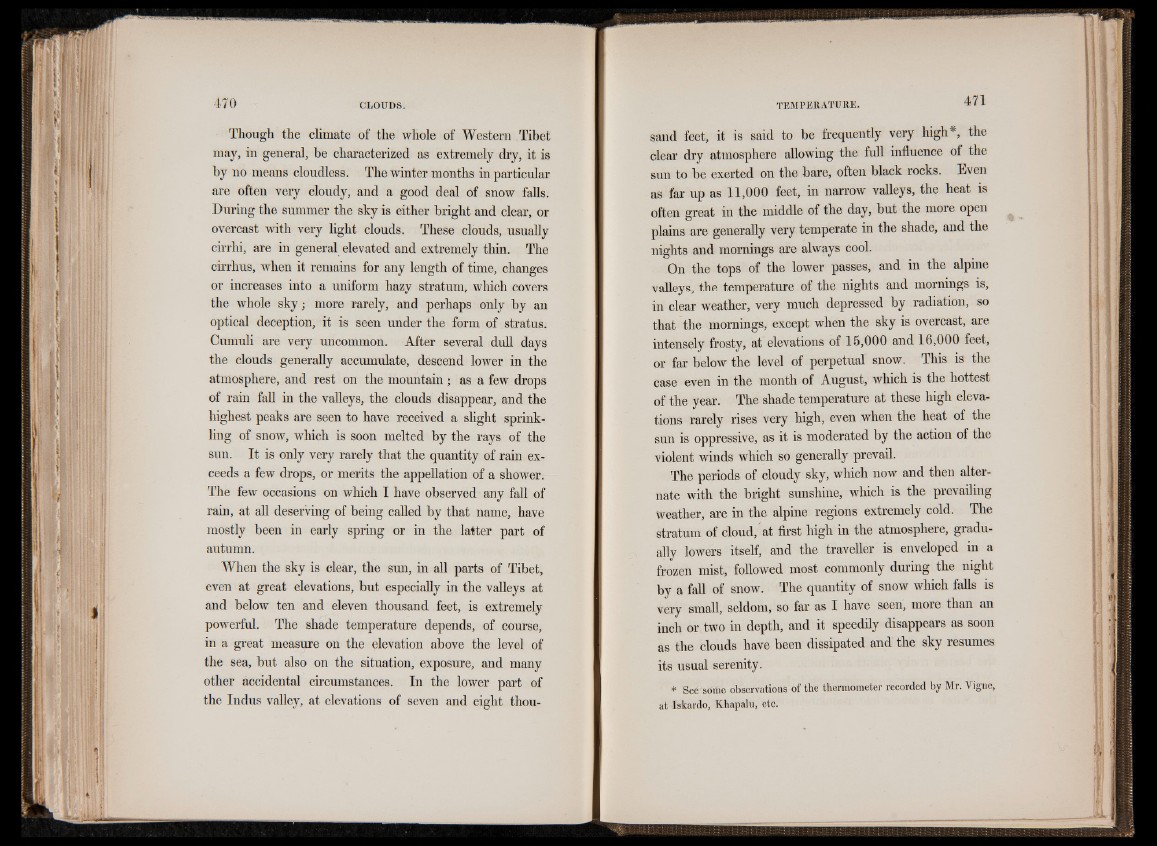
Though the climate of the whole of Western Tibet
may, in general, be characterized as extremely dry, it is
by no means cloudless. The winter months in particular
are often very cloudy, and a good deal of snow falls.
During the summer the sky is either bright and clear, or
overcast with very light clouds. These clouds, usually
cirrhi, are in general elevated and extremely thin. The
cirrhus, when it remains for any length of time, changes
or increases into a uniform hazy stratum, which covers
the whole sky; more rarely, and perhaps only by an
optical deception, it is seen under the form of stratus.
Cumuli are very uncommon. After several dull days
the clouds generally accumulate, descend lower in the
atmosphere, and rest on the mountain; as a few drops
of rain fall in the valleys, the clouds disappear, and the
highest peaks are seen to have received a slight sprinkling
of snow, which is soon melted by the rays of the
sun. It is only very rarely that the quantity of rain exceeds
a few drops, or merits the appellation of a shower.
The few occasions on which I have observed any fall of
rain, at all deserving of being called by that name, have
mostly been in early spring or in the latter part of
autumn.
When the sky is clear, the sun, in all parts of Tibet,
even at great elevations, but especially in the valleys at
and below ten and eleven thousand feet, is extremely
powerful. The shade temperature depends, of course,
in a great measure on the elevation above the level of
the sea, but also on the situation, exposure, and many
other accidental circumstances. In the lower part of
the Indus valley, at elevations of seven and eight thousand
feet, it is said to be frequently very high*, the
clear dry atmosphere allowing the full influence of the
sun to be exerted on the bare, often black rocks. Even
as far up as 11,000 feet, in narrow valleys, the heat is
often great in the middle of the day, but the more open
plains are generally very temperate in the shade, and the
nights and mornings are always cool.
On the tops of the lower passes, and in the alpine
valleys, the temperature of the nights and mornings is,
in clear weather, very much depressed by radiation, so
that the mornings, except when the sky is overcast, are
intensely frosty, at elevations of 15,000 and 16,000 feet,
or far below the level of perpetual snow. This is the
case even in the month of August, which is the hottest
of the year. The shade temperature at these high elevations
rarely rises very high, even when the heat of the
sun is oppressive, as it is moderated by the action of the
violent winds which so generally prevail.
The periods of cloudy sky, which now and then alternate
with the bright sunshine, which is the prevailing
weather, are in the alpine regions extremely cold. The
stratum of cloud, at first high in the atmosphere, gradually
lowers itself, and the traveller is enveloped in a
frozen mist, followed most commonly during the night
by a fall of snow. The quantity of snow which falls is
very small, seldom, so far as I have seen, more than an
inch or two in depth, and it speedily disappears as soon
as the clouds have been dissipated and the sky resumes
its usual serenity.
* See some observations of the thermometer recorded by Mr. Yigne,
at Iskardo, Khapalu, etc.